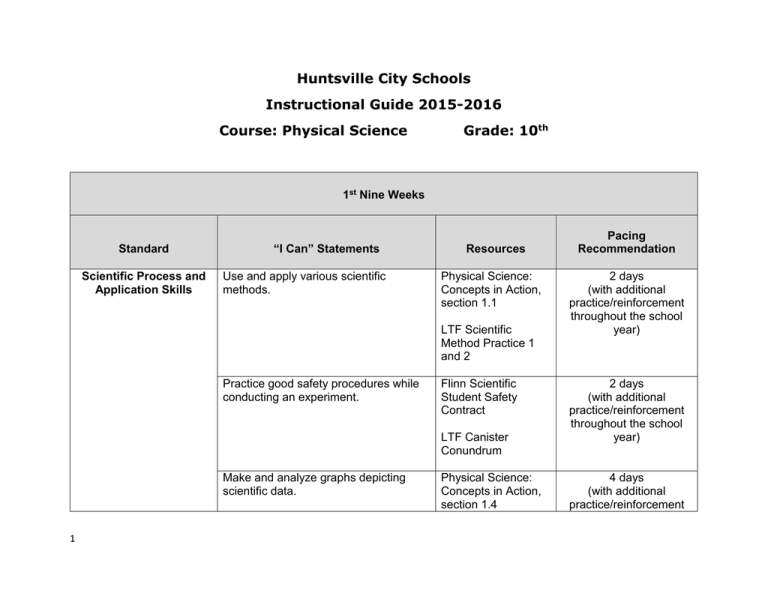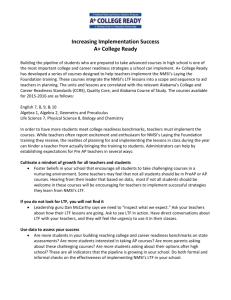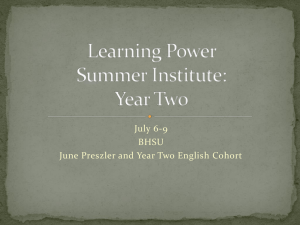Physical Science - Huntsville City Schools
advertisement

Huntsville City Schools Instructional Guide 2015-2016 Course: Physical Science Grade: 10th 1st Nine Weeks Standard Scientific Process and Application Skills “I Can” Statements Use and apply various scientific methods. Resources Physical Science: Concepts in Action, section 1.1 LTF Scientific Method Practice 1 and 2 Practice good safety procedures while conducting an experiment. Flinn Scientific Student Safety Contract LTF Canister Conundrum Make and analyze graphs depicting scientific data. 1 Physical Science: Concepts in Action, section 1.4 Pacing Recommendation 2 days (with additional practice/reinforcement throughout the school year) 2 days (with additional practice/reinforcement throughout the school year) 4 days (with additional practice/reinforcement LTF Bar Graphs and Histograms throughout the school year) LTF Line Graphs LTF Pie Charts Make accurate measurements while performing experiments. Physical Science: Concepts in Action, section 1.3 LTF Numbers in Science COS 5: Describe physical and chemical changes in terms of endothermic and exothermic processes. 2 days (with additional practice/reinforcement throughout the school year) Differentiate between pure substances and the different types of mixtures. Physical Science: Concepts in Action, section 2.1 3 days Compare and contrast physical and chemical properties of matter. Physical Science: Concepts in Action, sections 2.2 and 2.3 3 days Relate physical and chemical changes in terms of changes in energy. Physical Science: Concepts in Action, sections 2.2 and 2.3 3 days LTF Cool Chemical Reaction Differentiate between solids, liquids, and gases based on the traditional definition and kinetic theory. 2 Physical Science: Concepts in Action, section 3.1 3 days PhET States of Matter Purdue Visualizations COS 8: Relate the law of conservation of energy to transformations of potential energy, kinetic energy, and thermal energy. Differentiate between phase changes in solids, liquids, and gases in terms of endothermic and exothermic processes. Explain why temperature does not change during phase changes. Physical Science: Concepts in Action, section 3.3 3 days phase change diagrams LTF Meltdown Khan Academy States of Matter COS 1: Recognize periodic trends of elements, including the number of valence electrons, atomic size, and reactivity. Compare and contrast the three subatomic particles, and their properties and locations. Physical Science: Concepts in Action, sections 4.2 and 4.3 3 days Distinguish the atomic number of an element from the mass number of an isotope and use these numbers to describe the structure of atoms. Physical Science: Concepts in Action, section 4.2 4 days PhET Build an Atom Differentiate between families and periods. 3 Physical Science: Concepts in Action, section 5.2 2 days LTF It’s in the Cards Categorize elements as metals, Physical Science: nonmetals, metalloids, and noble gases. Concepts in Action, section 5.2 1 day Relate the number valence electrons to the groups of the periodic table and to the properties of the elements in those groups. 4 days Physical Science: Concepts in Action, sections 4.3 and 5.3 Atomic Flipbook activity LTF Making Sense of That Chart on the Wall LTF Flame Tests Predict the reactivity of some elements based of their locations within a group. Physical Science: Concepts in Action, section 5.3 NOVA What Makes an Element Reactive? 4 1 day Huntsville City Schools Instructional Guide 2015-2016 Course: Physical Science Grade: 10th 2nd Nine Weeks Standard COS 3: Contrast the formation of ionic and covalent bonds based on the transfer or sharing of valence electrons. “I Can” Statements Describe how an ionic bond forms using an electron dot diagram. Resources Physical Science: Concepts in Action, section 6.1 Pacing Recommendation 3 days LTF Light Up My Life Khan Academy Bonding Describe how covalent bonds form through the sharing of electrons. Physical Science: Concepts in Action, section 6.2 LTF Electrolytes and Non-electrolytes PhET Build a Molecule 5 2 days COS 4: Use nomenclature and chemical formulas to write balanced chemical equations. Name and determine chemical formulas for ionic and molecular compounds. Physical Science: Concepts in Action, section 6.3 4 days LTF Chemical Nomenclature PhET Molecule Shapes Relate the role of valence electrons in both ionic and covalent bonding. Physical Science: Concepts in Action, sections 6.1 and 6.2 1 day LTF Chemical Bonding using marshmallow models Interpret chemical equations in terms of reactants, products, and conservation of mass. Physical Science: Concepts in Action, section 7.1 2 days PhET Reactants Products and Leftovers Balance chemical equations by manipulating coefficients. 6 Physical Science: Concepts in Action, section 7.1 4 days PhET Balancing Chemical Equations Classify chemical reactions as synthesis, decomposition, single replacement, double replacement, or combustion reactions. Physical Science: Concepts in Action, section 7.2 2 days LTF Types of Chemical Reactions 7 COS 5: Describe physical and chemical changes in terms of endothermic and exothermic processes. Classify chemical reactions as exothermic or endothermic. COS 2: Identify solutions in terms of components, solubility, concentration, and conductivity. Describe how the physical properties of a solution can differ from those of its solute and solvent. Physical Science: Concepts in Action, section 7.3 2 day LTF Where’s the Heat? Physical Science: Concepts in Action, section 8.1 1 day Purdue Visualization Solutions Identify energy changes that occur during the formation of a solution. Physical Science: Concepts in Action, section 8.1 2 days Discuss the factors that affect solubility. Physical Science: Concepts in Action, sections 8.1 and 8.2 1 day LTF Sugar and Salt Solutions Define solubility and compare solutions as unsaturated, saturated, or supersaturated. Physical Science: Concepts in Action, section 8.2 2 days PhET Concentration Relate the pH of acids and bases to the characteristics of electrolytes and nonelectrolytes. Physical Science: Concepts in Action, sections 8.3 and 8.4 3 days LTF pHundamental PhET Acid Base Solutions COS 6: Identify characteristics of gravitational, electromagnetic and nuclear forces. COS 11: Describe the nuclear composition of unstable isotopes and the resulting changes to their nuclear composition. Relate nuclear forces to radioactivity. 1 day Physical Science: Concepts in Action, section 10.1 Classify nuclear radiation as alpha particles, beta particles, or gamma radiation. LTF Red Hot HalfLife Physical Science: Concepts in Action, section10.1 PhET Alpha Decay PhET Beta Decay 8 1 day Review and Assessment Differentiate between fission and fusion. Physical Science: Concepts in Action, section 10.4 2 days Identify uses and possible negative side effects of nuclear technology. Physical Science: Concepts in Action and Issues in Science in Ch. 10, Pg. 300 Radioactive Dating 4 days 2 days Benchmark Review 1 day Benchmark Assessment 9 Huntsville City Schools Instructional Guide 2015-2016 Course: Physical Science Grade: 10th 3rd Nine Weeks Standard “I Can” Statements COS 7: Relate velocity, acceleration, and kinetic energy to mass, distance, force and time. Interpret graphic representations of distance versus time. COS 12: Identify metric units for mass, distance, time, temperature, velocity, acceleration, density, force energy, and power. Solve problems for displacement, velocity, acceleration and time. Interpret graphic representations of velocity versus time. Resources Physical Science: Concepts in Action, sections 11.1, 11.2, 11.3 Pacing Recommendation 2 days 2 days LTF Walk the Line 4 days LTF Speed LTF Ramped Up LTF Changing Motion LTF Happiness is a Straight Line PhET Motion in 2D 10 PhET Maze Game Khan Academy Calculating Velocity or Speed Khan Academy Acceleration Describe conditions of balanced and Physical Science: unbalanced forces, including friction and Concepts in Action, gravity. sections 12.1, 12.2, 12.3 2 day Determine the resultant of collinear forces acting on a body and draw freebody diagrams of these forces. 2 days Relate Newton’s first law of motion to inertia. Use Newton’s second law of motion to calculate net force and acceleration of a body. Contrast mass and weight. LTF Barbie Doll Bungee LTF The Force to Be Reckoned With 1 day LTF Vectors 4 days LTF Forces on Objects LTF Not So Free Fall 1 day PhET Moving Man Solve simple momentum problems. 3 days PhET Ramp Forces and Motion Identify action-reaction pairs using Newton’s third law of motion. 11 1 day PhET Lunar Lander PhET Collision Lab Khan Academy Newtons Laws Solve problems for work and power. Determine the mechanical advantage of incline planes, wedges, and screws. Physical Science: Concepts in Action, sections 14.1, 14.2, 14.3, 14.4 4 days 1 day LTF Levers R Us Determine the mechanical advantage of levers and wheel and axles. Determine the mechanical advantage of pulleys. Solve problems for efficiency of simple machines. 1 day LTF Mechanical Advantage 1 day LTF Roller Coaster Fun 2 days LTF Running the Stairs Khan Academy Mechanical Advantage COS 8: Relate the law of conservation of energy to transformations of potential energy, kinetic 12 Relate simple formulas to the calculation of potential energy, kinetic energy, and work. Physical Science: Concepts in Action, section 15.1 5 days Give examples of the transformations of energy in a system. LTF Hot Dog 2 days energy, and thermal energy. 13 LTF Roller Coaster! Identify and explain situations in which mechanical energy is conserved and in which mechanical energy is not conserved, even though energy is conserved. 2 days PhET Energy Skate Park Huntsville City Schools Instructional Guide 2015-2016 Course: Physical Science Grade: 10th 4th Nine Weeks Standard COS 8: Relate the law of conservation of energy to transformations of potential energy, kinetic energy, and thermal energy. “I Can” Statements Resources Pacing Recommendation Identify the relationship between thermal energy and the temperature of a sample of matter. Physical Science: Concepts in Action, sections 16.1, 16.2 5 days Describe the flow of thermal energy between two samples of matter. LTF Molecular Motion 1 day Explain how thermal energy is transferred by radiation, conduction, and convection. PhET Energy Forms and Changes 1 day Wisc-Online Heat Transfer COS 9: Compare methods of energy transfer by mechanical and electromagnetic waves. 14 Distinguish between transverse and longitudinal mechanical waves. Physical Science: Concepts in Action, section 17.1 LTF Catch the Wave 5 days LTF Waves in a String LTF Waves in a Spring PhET Wave on a String Relate the physical properties of sound and light to wave characteristics. Physical Science: Concepts in Action, sections 17.2, 18.2 5 days PhET Sound Exploratorium Palm Pipes (OPTIONAL): Additional wave topics Appropriately rigorous topics include: - Discuss the relationship between the intensity of light and the amplitude of light waves - Draw and diagram the directions of reflected and refracted light rays - Use ray tracing to show the positions of an object, an image, and the focal point of a mirror or thin lens. Physical Science: Concepts in Action, additional sections in 17.1-4, 18.1-18.5 and/or 19.1-19.4 LTF Curved Mirrors LTF Mirror, Mirror on the Wall LTF Thin Lenses PhET Wave interference 15 (optional) (1-3 days) Physics Classroom Optics Bench Hyperphysics Thin Lens Calculator COS 10: Explain the relationship between electricity and magnetism. Differentiate between induction and conduction. Describe mechanical, magnetic and chemical methods used to create an electrical charge. Physical Science: Concepts in Action, section 20.1 4 days 5 days LTF Electrostatics LTF What in the World? PhET Balloons and Static Electricity PhET Magnets and Electromagnets Analyze simple electrical circuits using Ohm’s law. Physical Science: Concepts in Action, section 20.2, 20.3 LTF Short Circuits PhET Circuit Construction Kit 16 2 days Discuss the use of moving charges to create a magnetic field. Physical Science: Concepts in Action, section 21.2 2 days Discuss the use of a moving magnetic field to induce an electrical current in a closed loop of wire. LTF Electromagnetism 2 days PhET Electric Field Hockey PhET Generator (OPTIONAL) Electricity and magnetism applications Review and Assessment Appropriately rigorous topics include: - Identify the elements in an electrical circuit that are in series or in parallel. - Calculate the equivalent resistance of a network of resistors - Calculate the power in a circuit. - Distinguish between direct current and alternating current. - Describe the function and operation of electric motors and generators. Physical Science: Concepts in Action, sections 20.3, 20.4, 21.3 (optional) (1-3 days) LTF Electric Circuits – Simple LTF Electric Circuits – Complex PhET Ohms Law 2 days Benchmark Review 1 day Benchmark Assessment 17




